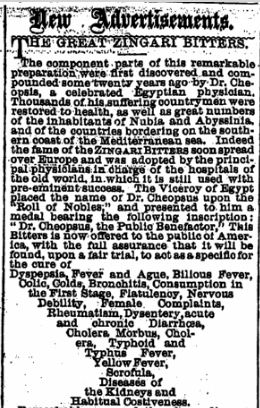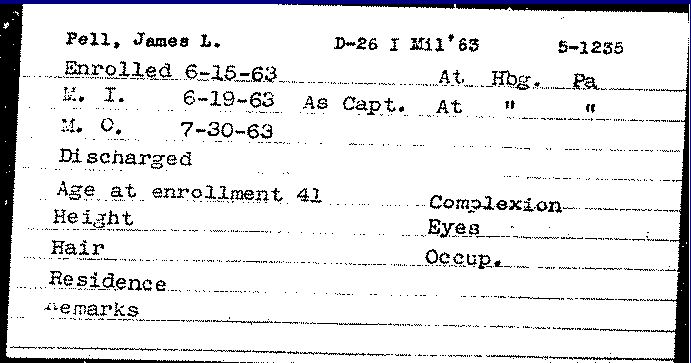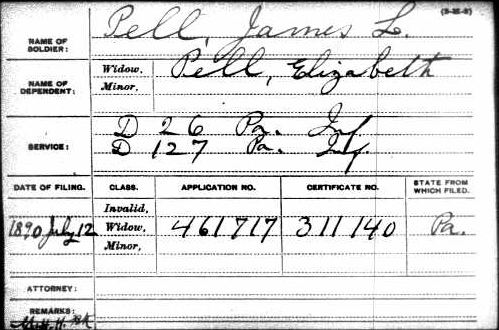Capt. James L. Pell and the Great Zingari Bitters
Posted By Norman Gasbarro on October 29, 2012
The first name listed on the Lykens G.A.R. Monument is that of Capt. James L. Pell, a founding member of the Heilner Post No. 232, G.A.R. of Lykens and Wiconisco, Dauphin County, Pennsylvania.
Who was James L. Pell other than being the highest ranking former officer involved in the creation of the Heilner Post at Lykens?
A newspaper search produced the following results for “James L. Pell”
THE GREAT ZINGARI BITTERS
The component parts of this remarkable preparation were first discovered and compounded some twenty years ago by Dr. Cheopsus, a celebrated Egyptian physician. Thousands of his suffering countrymen were restored to health, as well as great numbers of the inhabitants of Nubia and Abyssinia and of the countries bordering on the southern coast of the Mediterranean Sea. Indeed the fame of the ZINGARI BITTERS soon spread over Europe and was adopted by the principal physicians in charge of the hospitals of the old world, in which it is still used with pre-eminent success. The Viceroy of Egypt placed the name of Dr. Cheopsus upon the “Roll of Nobles” and presented to him a medal bearing the following inscription: “Dr. Cheopsus, the Public Benefactor.” This bitters is now offered to the Public of America with the full assurance that it wil be found, upon a fair trial, to act as a specific for the cure of Dyspepsia Fever and Ague, Bilious Fever, Colic, Colds, Bronchitis, Consumption in the First Stage, Flatulency, Nervous Debility, Female Comlaints, Rheumatism, Dysentery, acute and chronic Diarrhea, Cholera, Morbus, Cholera, Typhoid and Typhus Fever, Yellow Fever, Scrofula, Diseases of the Kidneys and Habitual Costiveness.
Remarkable cures of the above diseases have been effected by its use, as numerous certificates, many from regular physicians, fully attest; and it is destined to supercede any preparation extant. As an agreeable tonic, and an invigorating beverage, it has no equal. Thus the ZINGARI BITTERS has SOUL as well as BODY, and as a preventive DISEASES has no SUPERIOR.
A FEW WORDS TO LADIES. – The use of the ZINGARI BITTERS will give you that soft, semi-transparent complexion which the God of nature (designing women to be the loveliest of his works), fully intended that you should have for it is nature’s own powder and paint combined. By purifying the blood, stimulating the pigmentary cells of the dermis, or true skin, and imparting health and life throughout the entire system, it gives that smooth clearness and beauty to the complexion so much to be desired – removing all roughness, blotches, freckles and that yellow, sickly look so common in our day; and what is even better than this, it cures every species of female irregularities and disease.
Price $1 per bottle.
Principal Depot, Harrisburg, Pa.
RAHTER & HAUSE, Sole Proprietors.
This advertisement appeared nearly every week in the Harrisburg Patriot in the several years following the conclusion of the Civil War. Zingari Bitters was a tonic which claimed to cure nearly every malady known to man. Since this product was not regulated by any government agency, the manufacturers of the bitters relied on “testimonials” from well-known citizens as to the effectiveness. Among the many who endorsed the bitters was one “James L. Pell.”
Pell wrote from his Lykenstown home, 19 December 1866:
Mr. F. Rahter… Dear Sir: This is to certify that I was cured of the Dyspepsia by your Zingari Bitters. I suffered so much that I could hardly attend to my business – that of Engineer on the Lykens Valley Railroad, and after having tried all kinds of remedies I could hear of, without doing me any good, I was advised to try your BITTERS, and am happy to state that I am as well as I ever was, and I am certain that I own my cure to your great ZINGARI BITTERS. Yours respectfully, James L. Pell Jr.
The testimonial came complete with a sworn affidavit via the local Justice of the Peace.
Capt. Pell’s statement was one of many supporting this potion. The first statement was from former Pennsyvlania Governor David R. Porter who claimed it cured him of bowel trouble. This was followed by one from David Wills, the President of the Gettysburg National Cemetery, by another from a well known minister of the Gospel living in Carroll County, Maryland, and by others who were lawyers, doctors, and ordinary citizens. Each named the disease that was miraculously cured by this Dauphin County product.
According to Wikipedia, a “bitters’ is “an alcoholic beverage flavored with herbal essences and has a bitter or bittersweet flavor. Numerous brands of bitters were formerly marketed as patent medicines, but are now considered to be digestifs, rather than medicines. They commonly have an alcoholic strength of 45% ABV and are used as digestifs and as flavoring in cocktails.
The bottles in which bitters were sold in the 19th century have become collectors items. The one shown above, is from a web site which is hosted by Antique Bottle Collectors Haven. It’s an actual Zingari Bitters bottle, the neck of which was in the form of a woman’s leg.
Of course, James L. Pell had no medical training nor did his occupation qualify him as a credible endorser of the Zingari Bitters. His local popularity -because of the role he played in the Civil War – and, as is now being discovered, his family connections with many others from the Lykens Valley who served in the war – undoubtedly made his testimonial more believable.
In 1850, James L. Pell was living in Wiconisco, Dauphin County, Pennsylvania, and working as a sawyer. He was married to Mary Wareham and had two small children, William Pell, age 4, and Catherine Pell, an infant. By 1860, still living in Wiconisco, he was working as a railroad engineer on the Lykens Valley Railroad – a position he would hold for the remainder of his working years. Three new children appear in the 1860 census – Mary Pell, age 8; Samuel Pell, age 5; and Thomas Pell, age 4.
After the Civil War started, James L. Pell enlisted in the 127th Pennsylvania Infantry, Company D, as a Corporal, at Harrisburg, 9 August 1862, and served until 29 May 1863. He was older than most in his company, volunteering at the age of 39.
The Civil War Draft of 1863 saw him declare his prior service in the 127th Pennsylvania Infantry for 9 months – with residence in Wiconisco Township, and still working as an engineer.
Then, at age 41, James L. Pell again was called to service – this time to meet the Emergency of 1863. As the Captain of the 26th Pennsylvania Infantry Militia [26th Pennsylvania Infantry], Company D, he served from 19 June 1863 through discharge on 30 July 1863. His service during this time period earned him recognition on the Pennsylvania Memorial at Gettysburg (see below).
Following the Civil War, James L. Pell remarried (his first wife Mary died) and he moved to Millersburg, the other terminus of the Lykens Valley Railroad where he spent a great deal of time during his working years (his locomotive was turned around at the Millersburg roundhouse/turntable). As a resident of Millersburg (at least in 1870), Capt. Pell should have also been recognized by the Kilpatrick G.A.R. Post there when the Millersburg G.A.R. Soldier Monument was created – but his name does not appear on that plaque. Additional children born during this period include Emma Drucilla Pell, who later married George D. Dietrich, son of Civil War soldier Elias Dietrich. Other children of James L. Pell born to the second wife are still being researched.
As for the children born of the first wife, one of the grandchildren the son Thomas Pell, Karl Pell, married a direct descendant of Harrison Riegle of Lykens Township. There are many other inter-relationships waiting to be discovered.
There is no record that James L. Pell ever applied for a Civil War pension. Perhaps the Zingari Bitters actually cured him of all his ailments – including any that he may have obtained as a result of his Civil War service. He died 28 September 1889, and is buried in the I.O.O.F. Cemetery in Lykens Borough.
The Pension Index Card indicates that his second wife was the widow claimant for the Civil War benefits that James never applied for or received.
James L. Pell‘s surviving widow was the former Elizabeth Romberger (1829-1914), daughter of Solomon Romberger. Elizabeth [Romberger] Pell died in Lykens and her obituary from the Lykens Standard of 2 October 1914 states that she was born on the Sheafer Farm, Wiconisco Township, 18 November 1829. Surviving Mrs. Pell were two sisters and two brothers. One surviving sister, Catherine [Romberger] Myers, of Lykens, was married to George W. Myers, a Civil War veteran who is named on the Lykens G.A.R. Monument. The other surviving sister, Mary [Romberger] Fuller or Fulmer, of Potter County, Pennsylvania, was married to Augustus George Walborn Fowler (or Fuller), who served in the army at the end of the Civil War. Simon Romberger, a brother of Mrs. Pell, was residing in the Veterans’ Home in Dayton, Ohio; his name appears on the Lykens G.A.R Monument. Finally, John Romberger, a brother living in Small Valley, Jackson Township, Dauphin County, was another Civil War veteran and is also named on the Lykens G.A.R. Monument. The process of checking Mrs. Pell’s other siblings who died before 1914 is ongoing and it is possible that more links to Civil War service may be revealed soon!
Elizabeth [Romberger] Pell is buried in Union Cemetery in Lykens Borough.
The only mention of Capt. James L. Pell in the Commemorative Biographical Encyclopedia of Dauphin County appears in the biographical sketch of Col. William W. Jones, train dispatcher and yardmaster of the Lykens Valley Railroad (also called the Summit Branch Railroad) – who served under Capt. Pell in the 26th Pennsylvania Infantry (Emergency of 1863). Because Capt. Pell died in 1889, he probably was missed by the authors and editors of the encyclopedia. For a free download of this work, click here.
This post is an initial response to a comment made to another post on this blog – that of the Muir All Wars Memorial – by Betty Pell who is seeking information on Capt. James L. Pell, an ancestor of her husband. Mrs. Pell also made an inquiry indirectly through Sally Reiner, President of the Lykens-Wiconisco Historical Society. Any readers who can supply more information on Capt. Pell are urged to do so either by commenting on this post, submitting an e-mail to the blog, or by submitting an e-mail to Sally Reiner. Expecially needed are family pictures and stories!
Some of the information for this post was taken from a genealogy of the Welker family recently provided by Larry Welker. The newspaper articles on Zingari Bitters were obtained through the online resources of the Free Library of Philadelphia. Pension Index Cards are from Ancestry.com and Fold3 and reference materials available in the National Archives in Washington, D.C. Civil War Draft Registration lists are from Ancestry.com. Pennsylvania Veterans’ Index Cards are from the Pennsylvania Archives.
 ;
;










I cannot offer any direct help, but I can point you to another source. I shop Civil War Emporium a lot and they have some books on genealogy. There is one book in particular that might be of interest. The Pennsylvania Civil War Regimental Histories book collection is a group of 58 books that detail the histories of various Pennsylvania based regiments during the Civil War. Many of the books are illustrated with specific events relating to their service as well as portraits of some of the members. These books are an excellent resource for the Civil War history buff as well as for those doing Civil War genealogy research. Heres the link http://www.civilwaremporium.com/product/HAC537_Pennsylvania-Civil-War-Regimental-Histories-Book-Collection-on-DVD. I hope it helps you.